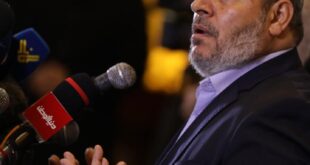
Two al Qaeda leaders were reportedly killed in a drone strike in Syria’s Idlib province earlier today, according to jihadists on social media. Pictures of the car carrying them were posted on Telegram and other messaging applications.
It appears the vehicle was struck with a R9X, a version of the Hellfire missile that has been used in previous targeted killings, or a similar weapon. The Wall Street Journal reported last year that the R9X doesn’t explode upon impact, but instead deploys a “halo of six long blades” that slice through their target. The missile was intended to further limit civilian casualties.
Jihadists identified the two men killed as Abu al Qassam al Urduni and Bilal al Sanaani. If confirmed, their deaths would be significant. The U.S. government hasn’t officially commented on the report.
Abu al Qassam (also known as Khaled al Aruri and Abu Ashraf) is an al Qaeda veteran whose jihadist career dates back to the 1990s. He was one Abu Musab al Zarqawi’s closest companions, as the two grew up in Jordan and then worked together from the early 1990s until Zarqawi’s demise in 2006. He was also Zarqawi’s brother-in-law.
In 2015, Abu al Qassam was one of five senior al Qaeda figures who were freed in exchange for an Iranian diplomat.
Since then, Abu al Qassam became one of al Qaeda’s top operatives in Syria. According to an expert monitoring team report submitted to the UN Security Council last year, he was the leader of Hurras al-Din (HAD), or the “Guardians of Religion” organization.
HAD grew out of the jihadist infighting that followed the formation of Hay’at Tahrir al Sham (HTS) in early 2017. It was initially led by Abu Hammam al-Shami, another al Qaeda veteran, but the UN’s analysts say Abu al Qassam took the helm at some point.
One of Zarqawi’s closest companions
Abu al Qassam’s early career is discussed at length in Jean-Charles Brisard’s book, Zarqawi: The New Face of Al-Qaeda. Brisard describes him as “one of Zarqawi’s closest lieutenants in Afghanistan and later in Iraq.”
According to Brisard, Zarqawi confessed to Jordanian officials that he established a terrorist outfit, dubbed “Bayat al Imam,” in the early 1990s with help from Abu Muhammad al-Maqdisi, an influential cleric who is still regularly cited in al Qaeda circles today. Though there is some ambiguity concerning events during this period, there is little doubt that Zarqawi and Abu al Qassam were already comrades. Zarqawi introduced Abu al Qassam and other members of his “inner circle” to Maqdisi during this time, according to Brisard. Abu al Qassam also helped Zarqawi woo new recruits in Jordan.
The two friends didn’t always see eye-to-eye, according to Brisard’s account. Abu al Qassam objected to some early plots targeting Jordan’s powerful General Intelligence Directorate (GID). Regardless, Abu al Qassam “retained Zarqawi’s trust throughout his career as a terrorist.”
Abu al Qassam and Zarqawi were imprisoned in Jordan for a period during the 1990s, but the two men were granted freedom as part of a general amnesty in March 1999. Abu al Qassam followed Zarqawi back to Afghanistan, where he worked in his friend’s camp in the western province of Herat. And after the 9/11 attacks, he fled with Zarqawi to Iraq, living for a time along the Iranian border before entering the Kurdish region. Brisard reports that Zarqawi and other members of their crew, including Abu al Qassam, met in Tehran in August 2001. They allegedly agreed to set up camps in Kurdistan at that time, working with Ansar al-Islam in the months that followed.
As Zarqawi’s own organization grew in power, so did Abu al Qassam’s role. Brisard describes him as Zarqawi’s “man for special missions in Iraq and abroad.” Authorities reportedly found that he had ties to the May 2003 suicide bombings in Casablanca, which left dozens dead and many more wounded. He sent $70,000 to Aziz Hummani, who used the money to finance the bombings, according to Brisard. The Washington Post reported later that same year that those same bombings were tied back to al Qaeda personnel then living in Iran, namely Osama bin Laden’s son, Saad.
Involved in controversies in Syria
At some point, Abu al Qassam was detained by the Iranian regime. After his release from Iranian custody in 2015, he became involved in the jihadists’ infighting in northwestern Syria. In mid-2016, Abu Muhammad al Julani announced that his group, Al Nusrah Front, was being rebranded as Jabhat Fath al Sham (JFS). Months later, JFS merged with several other groups to form Hay’at Tahrir al Sham (HTS), though some of those parties have since left the formation.
Sometime between Al Nusrah’s “disassociation” from al Qaeda in mid-2016 and its relaunch as HTS in early 2017, two senior al Qaeda leaders — Saif al Adel and Abdullah (a.k.a. Abu Muhammad al Masri) — were consulted on the issue. Although the pair had been released from Iranian custody alongside Abu al Qassam, they decided to stay inside Iran. From their perch inside the country, they rejected Julani’s moves.
One of Julani’s advocates, an HTS official known as Abu Abdullah al-Shami, argued that Adel and Abdullah didn’t have the authority to overrule Julani and his comrades because the two were “in an enemy state (Iran),” where “they are being held there against their will.” In other words, the two al Qaeda leaders were supposedly detained inside Iran and, therefore, not able to freely consider the matter.
But Abu al-Qassam quickly rejected Abu Abdullah al-Shami’s argument in a post online, explaining that Saif al Adel and Abdullah “left prison and they are not imprisoned.” The two al Qaeda managers “are forbidden from traveling until Allah makes for them an exit,” he wrote, but “they move around and live their natural lives except for being allowed to travel.”
U.S. infrequently hunts al Qaeda officials and operatives in Syria
America’s drones do not target senior al Qaeda personnel in Iran, but they have been deployed across Syria on multiple occasions.
In December 2019, another HAD official, Bilal Khuraysat, was killed in an airstrike. Khuraysat (a.k.a. Abu Khadija al-Urduni) was also a native of Jordan. He was a significant ideological figure, as he penned tracts defending al Qaeda and criticizing the Islamic State, among other topics.
Another Jordanian al Qaeda leader, Iyad Nazmi Salih Khalil (a.k.a. Abu Julaybib al-Urduni), was killed in a drone strike in late 2018. Like Abu al Qassam, Abu Julaybib was close to Zarqawi.
The U.S. has also carried out airstrikes against al Qaeda targets deemed a threat to the West, including in June and August of 2019.
In Feb. 2017, the U.S. killed one of Ayman al Zawahiri’s top deputies, Abu al Khayr al Masri, in a drone strike. Abu al Khayr was killed with a R9X missile, according to the Wall Street Journal.
If the reports of the demise of Abu al Qassam and Bilal al Sanaani are accurate, then it appears that they died in an airstrike with a R9X, or a similar missile, as well.
 Eurasia Press & News
Eurasia Press & News



